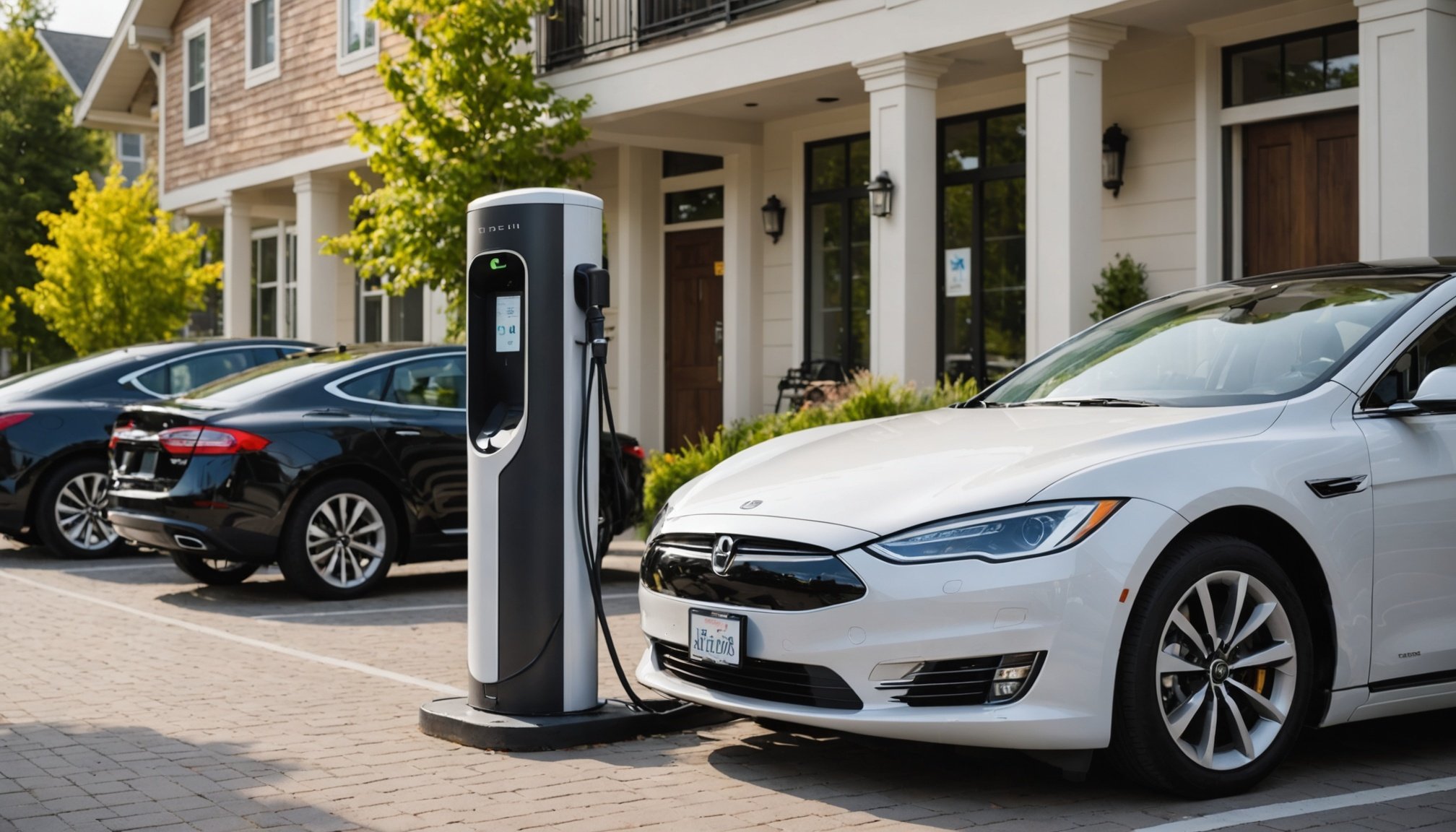Overview of EV Charging Station Installation in Multi-Unit Residences
The presence of EV charging stations in multi-unit residences is increasingly critical as electric vehicles (EVs) gain popularity. Installation in such locations supports eco-friendly transport and enhances property attractiveness.
Current Trends and Demand
Recent trends show a rising demand for EV charging solutions in multi-unit residences. As more people transition to electric vehicles, the need for accessible charging infrastructure grows. Property managers are recognizing this shift and prioritizing the installation process to meet resident demands and sustainability goals.
Additional reading : Top Strategies for Restoring Historical Properties in Canterbury: A Complete Guide
Benefits for Property Managers
For property managers, offering EV charging stations can be a competitive advantage. It’s an incentive that potentially adds value to the property and attracts environment-conscious tenants. The installation of these units can be seen as a long-term investment, aligning with green property initiatives and enhancing overall marketability.
Resident Advantages
For residents, having on-site EV charging is a significant convenience. It eliminates the need for time-consuming trips to public charging stations and integrates seamlessly into daily routines. Moreover, multi-unit residences that invest in these infrastructures support sustainable living and foster a community committed to reducing carbon footprints.
In the same genre : Top Techniques for UK Landlords to Effectively Resolve Tenancy Disputes
In sum, integrating EV charging stations is essential for modernizing multi-unit residences, benefiting both property stakeholders and residents alike.
Site Assessment for EV Charging Stations
Conducting a site assessment is a crucial step in planning for EV charging stations. One of the primary considerations is evaluating the property layout and available space. This involves a detailed site analysis to ensure there is sufficient room for the installation of charging units while allowing for easy access.
Moreover, identifying the electrical infrastructure is vital to determine the feasibility of the project. An evaluation of the current power supply will reveal whether any upgrades are necessary to support the additional load. This might involve consulting with electricians to assess the capacity and preparing for possible enhancements to meet the station’s energy demands.
Another significant aspect is considering the parking needs and accessibility for residents. Determining the best location for these stations requires a careful balance between convenience and space utilization. It’s essential to place charging spots where they can be easily accessed by users without disrupting daily parking patterns.
In conclusion, a thorough site assessment involves thorough location analysis and a feasibility study, ensuring that all logistical and technical elements are aligned effectively. By considering property layout, electrical infrastructure, and parking requirements, developers can make informed decisions and plan an efficient rollout of EV charging stations.
Electrical Capacity and Infrastructure Requirements
Before installing multiple charging stations, it’s crucial to evaluate the existing electrical capacity of the building. This ensures that the current power supply can handle additional energy demands without causing disruptions or safety hazards.
Start by conducting a thorough assessment of the building’s infrastructure. This involves reviewing the capacity of electrical panels and circuits to support potential upgrades. Understanding the baseline power supply helps in planning necessary improvements.
To accurately calculate energy demands, consider the power requirements of multiple charging points. Each point increases the overall energy load, making it vital to determine whether the existing system can manage this additional capacity. If not, upgrading the electrical panel and circuit can be a practical solution.
Upgrades might include reinforcing electrical circuits or possibly installing higher-capacity transformers. This ensures a seamless integration of charging stations into the building’s infrastructure. Moreover, such improvements enhance future scalability, allowing for more stations as demand increases.
Addressing these aspects effectively requires collaboration with professionals. Electrical engineers can provide detailed assessments and recommend appropriate steps for upgrading infrastructure, ensuring that the building’s power supply is robust and well-prepared for the introduction of multiple charging stations without compromising safety or efficiency.
Types of Charging Stations Suitable for Multi-Unit Residences
When considering charging station types for multi-unit residences, understanding the differences between Level 1, Level 2, and DC fast charging stations is crucial.
Level 1 charging uses a standard household outlet and offers the slowest charging solution. This type is generally suited for residents with low daily mileage who can afford to recharge their vehicles overnight or during extended periods of inactivity.
In contrast, Level 2 charging delivers faster energy transfer, making it apt for residents with moderate mileage requirements. Typically requiring a 240-volt outlet, Level 2 stations are common in residential complexes where individuals seek a balance between speed and cost-effectiveness.
For those requiring rapid charging, DC fast charging is the superior choice. These stations use direct current to recharge vehicles significantly faster than Level 1 and Level 2 options. However, they are more expensive to install and operate, often fitting best in high-traffic areas or as a shared resource for residents with urgent charging needs.
The choice of charging station involves assessing resident needs and usage patterns. Factors like the number of electric vehicles, typical commuting distance, and frequency of charging influence the decision, ensuring that the infrastructure meets both current and future demands effectively.
Cost Considerations and Budgeting for Installation
When pondering installation costs for a new project, it’s crucial to differentiate between upfront expenses and the long-term savings one might achieve. Initial costs often include purchasing equipment, hiring professional services, and potential infrastructure modifications. On the flip side, long-term savings could stem from reduced maintenance fees and energy efficiency.
Financial planning should account for both these elements. Understanding potential financial challenges and identifying budget constraints is vital. Unexpected expenses, such as unplanned repairs or delayed installations, can strain the budget. Thus, maintaining an emergency fund could be an essential part of a prudent financial plan.
A proactive approach to budgeting may involve exploring cost-sharing strategies among different stakeholders, such as residents and owners in a communal living environment. This could mean dividing the expenses based on usage or benefits derived from the installation – encouraging a sense of shared responsibility.
To optimize financial planning, consider consulting with a financial advisor who can offer tailored advice. A well-thought-out plan addresses potential hurdles and ensures that the project remains on track financially. Implementing these strategies not only helps manage upfront installation costs but also positions the community to reap long-term savings, fostering a sustainable and economically viable environment.
Legal Compliance and Regulations
Navigating legal compliance for EV charging installations can seem daunting, but understanding the framework makes it manageable. Initially, it’s crucial to understand the local and state regulations that apply. Each region may have specific requirements that dictate how and where EV chargers can be installed, adding a layer of complexity for those unfamiliar.
Zoning regulations play a pivotal role, as these dictate where installations can occur within city or district limits. For instance, certain residential areas might have restrictions on visible structures like charging stations. As a result, familiarising oneself with zoning laws is essential to avoid potential disputes or fines.
Equally important are building codes. These codes ensure that all installations adhere to safety standards, safeguarding both users and property. Whether it’s the proper electrical wiring or the structural integrity of the installation, building codes provide a comprehensive checklist to follow.
The process often involves securing permits and undergoing inspections to ensure all regulations are met. This may include site evaluations by officials to approve the installation plans. By understanding these legal frameworks, the journey to successfully installing EV chargers becomes a smoother endeavor, reducing the risk of unforeseen obstacles and aligning with necessary standards.
User Accessibility and Management
User accessibility in electric vehicle (EV) charging stations is pivotal for ensuring residents find charging straightforward and stress-free. A user-friendly interface is at the heart of resident interaction. This involves designing intuitive systems that allow EV owners to quickly identify and connect to available stations.
Implementing effective user access systems plays a crucial role in enriching the user experience. This can include RFID cards, mobile apps, or keypads which simplify station login. Seamless payment solutions should accompany these systems, offering multiple options such as contactless payments, mobile wallets, or subscription-based services to suit diverse user preferences.
Another significant aspect of EV management is optimizing the use of charging stations to prevent overcrowding and ensure fair access. This involves strategic scheduling, persisting with real-time updates on station availability via digital platforms, and possibly integrating a queue management system during peak hours.
For resident interaction to be effective, feedback mechanisms can be introduced. They allow users to contribute to service improvements by sharing their experiences and suggestions, further refining user accessibility. Overall, a well-managed system not only enhances user satisfaction but also fosters greater community acceptance and support of EV infrastructure advancements.
Incentives and Financial Assistance for Installation
Navigating the landscape of financial incentives for EV charging installations can unlock a plethora of opportunities for property owners. Both federal and state programs offer substantial support to encourage the adoption of electric vehicles through the development of charging infrastructure.
Federal and State Incentives
At the federal level, tax credits are a significant financial incentive. These credits can cover a portion of the costs associated with the installation of charging stations. Meanwhile, state-level programs may offer additional subsidies or rebates, which can vary based on your location. This dual-layer approach ensures that property owners can benefit from multiple avenues of support.
Availability of Grants and Rebates
Grants and rebates specifically designed for EV infrastructure are available and can significantly reduce upfront costs. Property owners should research local programs, as some cities and regions offer unique financial incentives to promote sustainability initiatives. Staying informed about these opportunities can lead to substantial savings.
Maximizing Funding Opportunities
To maximize these financial incentives, property owners should consider combining federal, state, and local programs for optimal benefits. Coordinating with financial advisors or specialized consultants who understand the intricacies of these programs can also prove beneficial. Leveraging these resources effectively can significantly lower installation costs and help in the transition to a greener future.
Case Studies of Successful EV Charging Installations
Exploring successful installations in multi-unit residences provides a deeper understanding of the best practices that ensure seamless electric vehicle (EV) charging infrastructure. These case studies showcase practical applications where key takeaways offer insights into overcoming common obstacles.
In one such instance, a residential complex successfully integrated EV charging stations by collaborating with utility companies. This partnership allowed the complex to tailor their electric setup specifically for high demand, ensuring all residents had access without straining the existing electrical capacity.
A notable lesson from successful projects is the value of engaging residents early in the process. Educating them about the benefits and operational aspects of EV charging often leads to higher adoption and support.
Certain case studies also highlight innovative approaches, such as implementing tiered pricing to manage peak demand, which both controls costs and encourages off-peak usage. Residents in these locations found the financial incentives a compelling reason to adjust their charging habits, leading to more effective usage patterns.
These examples emphasize that while challenges exist in installing EV charging, unique solutions tailored specifically to the project’s needs can make a significant difference. Future installations can draw on these experiences, improving efficiency and satisfaction amongst users and stakeholders alike.
Selecting the Right Vendor for Installation
Choosing the appropriate vendor selection is crucial in ensuring a smooth installation process. The first step is to analyse the criteria for selecting experienced vendors and contractors. Important factors include assessing their expertise, which can be determined by reviewing previous projects they’ve completed successfully. A vendor with a strong track record will likely have the necessary skills and knowledge to handle your project, which minimises potential issues.
Another key consideration is the vendor’s reputation. A well-regarded vendor often indicates reliability and quality. You can discover a vendor’s standing by reading customer reviews or asking for references from past clients. Exploring these sources will give you insight into the vendor’s working habits and dependability.
Building strong partnerships with your selected vendor is also vital. This collaboration can create a foundation for ongoing support and maintenance. Open communication lines and regular check-ins can help foster a positive relationship. A responsive vendor is more likely to address any concerns swiftly, ensuring your project remains on track.
By prioritising contractor evaluation, understanding vendor reputations, and establishing reliable partnerships, you significantly enhance your project’s chance of success. This well-rounded approach ensures both the installation process’s efficacy and future system performance.











